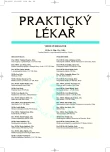The importance of serum iron levels in patients with chronic hepatitis B and C.
Authors:
J. Stránský 1; K. Krátká 1; J. Stříteský 2
Authors‘ workplace:
I. interní klinika FNKV a 3. LF UK Praha
Přednosta: prof. MUDr. Jiří Horák, CSc.
1; Ústav patologie 1. LF UK Praha
Přednosta: prof. MUDr. Ctibor Povýšil, DrSc.
2
Published in:
Prakt. Lék. 2007; 87(4): 235-237
Category:
Of different specialties
Overview
The clinical importance of serum iron levels in hepatitis B and C patients is not fully known. Serum iron levels were tested in a total of 473 patients, of whom 74 were HBsAg positive, 207 anti-HCV positive, and 192 were random controls with other liver diseases. Serological markers of HBV and HCV infection were tested by ELISA methods, and a liver biopsy was performed in 57 % of hepatitis B and C patients.
Results:
Mean serum iron concentrations were highest in the HCV infected patients (p<0.05 vs. HBV and controls); although these concentrations were not higher than the upper limit of the normal value. Mean serum ALT and AST activity was significantly higher in chronic hepatitis C patients than in hepatitis B patients (p<0.003, p<0.001 resp.) and in comparison to the controls. In a subgroup of 106 liver cirrhosis patients mean serum iron levels were significantly higher in patients with chronic hepatitis B and C (p<0.05) and ALT and AST activity was also higher in comparison with controls (p<0.001, p<0.001).
Conclusions:
Significantly higher serum iron levels were detected in patients with chronic hepatitis B and C, and although they were below the upper limit of what is considered a normal value, it was an important finding because they were accompanied by significantly higher ALT and AST activity in both groups of hepatitis patients.
Key words:
iron, chronic hepatitis B, chronic hepatitis C, liver cirrhosis.
Labels
General practitioner for children and adolescents General practitioner for adultsArticle was published in
General Practitioner

2007 Issue 4
Most read in this issue
- Todays trends of diagnostics and treatment of scaphoid bone fractures
- Extensive trombosis of thoracic aorta – an unusual source of acute peripheral arterial embolism.
- Epileptic fit as a syncope equivalent in severe aortic stenosis.
- Smoking and skin
